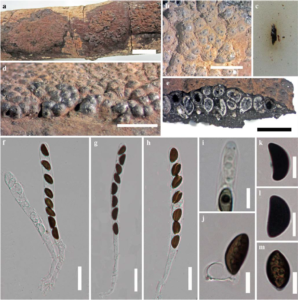Hypoxylon monticulosum Mont., Syll. Gen. Sp.Crypt., p. 214. 1856.
Index Fungorum number: IF 165810; Facesoffungi number: FoF 000302, Fig. 1
Holotype – BPI 589948
Saprobic on decorticated wood. Sexual morph: Ascostromata 0.3–5 × 0.5–2.5 × 0.5–1 cm (x̄ = 3.2 × 1.8 × 0.7 cm), pulvinate to effuse-pulvinate, with conspicuous perithecial mounds, surface rust (39) to sepia (63), blackish, shiny when mature; with blackish, woody to carbonaceous tissue immediately beneath surface and between perithecia, without apparent KOH-extractable pigments; the tissue below the perithecial layer 0.2–0.3 mm thick (x̄ = 0.2 mm), perithecia sphaerical to obovoid, 0.2–0.5 × 0.3–0.5 mm (x̄ = 0.3 × 0.4 mm), immersed in carbonaceous tissue, arranged as multi-layers, ostioles papillate, without apparent disk formation, paraphyses not seen. Asci (86–)90–130(–132) × (4.6–)5–7(7.3) μm (x̄ = 117 × 6.8 μm, n = 20), 8-spored, unitunicate, cylindrical, pedicellate, with discoid apical ring inconspicuously bluing in Melzer’s reagent, 0.5–1.2 × 1.5–2.5 μm (x̄ = 1 × 2.1 μm, n = 20). Ascospores (7.7–)8–12.5(–12.9) × (3.2–)3.5–5(–5.3) μm (x̄ = 10.4 × 4.8 μm), uniseriate, one-celled, ellipsoid- inequilateral, with narrowly rounded ends, brown to dark brown, with sigmoid germ slit the entire spore length, perispore dehiscent in 10 % KOH, smooth or with inconspicuous coil-like ornamentation, epispore smooth. Asexual morph Undetermined.
Culture characters – Colonies onOA at 25–28 °C covering Petri-dish in 3 weeks, at first white, becoming hazel (88) to pale mouse gray (117), cinnamon (62) towards the centre, velvety, azonate, with diffuse margins, usually with vinaceous buff (86) to isabelline (65) pigments diffusing beyond colonies; reverse gray olivaceous (107) or greyish-sepia (106).
Material examined – THAILAND, Chiang Mai, Doi Pui mountain, on decaying wood, 2 December 2012, D.A. Daranagama and K.D. Hyde AXL 111 (MFLU 12–0827), living cultures, MFLUCC 13–0133; ibid., Doi Suthep mountain, on decaying wood, 12 December 2012, D.A. Daranagama and K.D. Hyde AXL 111 (MFLU 12–0848), living cultures, MFLUCC 12-0818.
GenBank Accession Numbers – ITS:KM052716; LSU: KM052717; RPB2: KM052719.
Notes – Hypoxylon monticulosum, H. submonticulosum and H. investiens are quite similar in their morphological characters which resulted in some old collections of H. investiens being named as H. monticulosum (Ju and Rogers 1996). Besides, the variable stromatal characters in H. investiens make it rather difficult to identify. For example, H. investiens possesses varying ostiolar characters. H. monticulosum and H. submonticulosum differ from H. investiens in the lack of apparent KOH-extractable pigments, while the latter has green–olivaceous KOH extractable pigments (Ju and Rogers 1996) . However, H. monticulosum has been reported to produce purple stromatal pigments when young but at the maturity, the pigments are not observable. Hypoxylon monticulosum has a blackish surface on mature stromata and even in the young stromata which sometimes make it different from others, coupled with Virgariella-like conidiogenous structures (Ju and Rogers 1996). Hypoxylon monticulosum has darker, inequilateral ascospores with dehiscent perispore in KOH as compared to the temperate H. submonticulosum. In GenBank there are sequences of H. monticulosum but many are from unverified strains. We introduce new ITS, RPB2, LSU and β-tubulin gene sequences from an authentic strain.

Fig. 1 Hypoxylon monticulosum (MFLU 12–0827) a Stromatal habit in wood b Ostioles seen from above c Stromata in KOH (note–lack of apparent colour formation) d Stroma in side view e Cross section of the stroma showing perithecia f Mature and immature ascus in water g Mature ascus in water h Ascospores in ascus showing germ slit i Ascus in Melzer’s reagent showing inconspicuous ascal apical apparatus j Dehiscent perispore in KOH k, l, m Ascospore in water. Scale bars: a=2 cm, b, d, e=1 mm, f-m=10μm.
